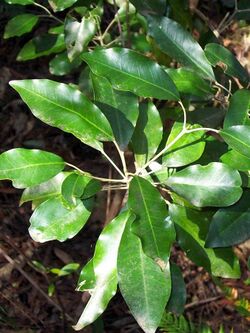Biology:Acronychia wilcoxiana
| Silver aspen | |
|---|---|

| |
| Acronychia wilcoxiana in the Royal Botanic Garden, Sydney | |
| Scientific classification | |
| Kingdom: | Plantae |
| Clade: | Tracheophytes |
| Clade: | Angiosperms |
| Clade: | Eudicots |
| Clade: | Rosids |
| Order: | Sapindales |
| Family: | Rutaceae |
| Genus: | Acronychia |
| Species: | A. wilcoxiana
|
| Binomial name | |
| Acronychia wilcoxiana | |
| Synonyms[1] | |
| |
Acronychia wilcoxiana, commonly known as silver aspen,[2] doughwood, snowwood or mushyberry,[3] is a species of small rainforest tree that is endemic to eastern Australia. It has simple, elliptical to egg-shaped leaves with the narrower end towards the base, relatively large groups of whitish flowers in leaf axils and broadly oval to more or less spherical, white fruit.
Description
Acronychia wilcoxiana is a tree that typically grows to a height of 9–15 m (30–49 ft) with pinkish brown or dark brown bark and a crown of dark green leaves. The leaves are arranged in opposite pairs, and are elliptical to egg-shaped with the narrower end towards the base, 70–210 mm (2.8–8.3 in) long and 25–90 mm (0.98–3.54 in) wide on a petiole 6–30 mm (0.24–1.18 in) long. The flowers are arranged in relatively large groups 30–65 mm (1.2–2.6 in) long in leaf axils, each flower on a pedicel 0.5–3 mm (0.020–0.118 in) long. The four sepals are 1.5–3 mm (0.059–0.118 in) wide, the four petals whitish and 7.5–9 mm (0.30–0.35 in) long and the eight stamens alternate in length. Flowering occurs from January to May and the fruit is a fleshy, conical to spherical drupe 12–15 mm (0.47–0.59 in) long. The seeds are black, oval and about 4.5 mm (0.18 in) long.[2][4][5]
Taxonomy
The silver aspen was first formally described in 1875 by Ferdinand von Mueller who gave it the name Pleiococca wilcoxiana and published the description in Fragmenta phytographiae Australiae.[6][7] In 1974 Thomas Hartley changed the name to Acronychia wilcoxiana in the Journal of the Arnold Arboretum.[5][8] The species name honours James Fowler Wilcox, a 19th-century collector of birds and plants in northern New South Wales.[9]
Distribution and habitat
Acronychia wilcoxiana grows in rainforest, mostly between Fraser Island in south-east Queensland and Gosford in central-eastern New South Wales and from sea level to an altitude of 450 m (1,480 ft) but a small population of about eight mature trees has been recorded at Primbee in the Illawarra district.[2][4][10]
Ecology
The fruit of A. wilcoxiana are eaten by rainforest birds, including the wompoo fruit-dove.[2]
Conservation status
Silver aspen is listed as of "least concern" under the Queensland Government Nature Conservation Act 1992.[3]
Use in horticulture
Germination from seed is not easy, however, the removal of the fleshy aril from the seed will improve results. Seeds may germinate after 6 to 12 months.[2]
References
- ↑ 1.0 1.1 "Acronychia wilcoxiana". Australian Plant Census. https://biodiversity.org.au/nsl/services/apc-format/display/74070. Retrieved 8 July 2020.
- ↑ 2.0 2.1 2.2 2.3 2.4 Floyd, A. G. (2008). Rainforest Trees of Mainland South-eastern Australia (2nd, Revised ed.). Lismore, New South Wales: Terania Rainforest Publishing. p. 350. ISBN 978-0-958943-67-3. http://rainforestpublishing.com.au/shop/rainforest-trees-of-south-eastern-australia/. Retrieved 2010-09-07.
- ↑ 3.0 3.1 "Species profile—Acronychia wilcoxiana (silver aspen)". Government of Queensland, Department of Environment and Science. https://apps.des.qld.gov.au/species-search/details/?id=12325. Retrieved 8 July 2020.
- ↑ 4.0 4.1 Hartley, Thomas G. (2013). Flora of Australia (Volume 26). Canberra: Australian Biological Resources Study. pp. 117–113. https://profiles.ala.org.au/opus/foa/profile/Acronychia%20wilcoxiana. Retrieved 8 July 2020.
- ↑ 5.0 5.1 Hartley, Thomas G. (1974). "A revision of the genus Acronychia (Rutaceae).". Journal of the Arnold Arboretum 55 (3): 516–517. doi:10.5962/p.324717. https://www.biodiversitylibrary.org/item/90519#page/527/mode/1up. Retrieved 2 July 2020.
- ↑ "Pleiococca wilcoxiana". APNI. https://id.biodiversity.org.au/instance/apni/501576. Retrieved 8 July 2020.
- ↑ von Mueller, Ferdinand (1875). Fragmenta phytographiae Australiae. Melbourne: Victorian Government Printer. pp. 117–118. https://www.biodiversitylibrary.org/item/7226#page/118/mode/1up. Retrieved 8 July 2020.
- ↑ "Acronychia wilcoxiana". APNI. https://id.biodiversity.org.au/instance/apni/486474. Retrieved 8 July 2020.
- ↑ Maiden, Joseph Henry (1908). "Wilcox, James Fowler (1823-1881)". Council of Heads of Australasian Herbaria, Australian National Herbarium. Commonwealth of Australia. http://www.anbg.gov.au/biography/wilcox-james-fowler.html. Retrieved 12 September 2010.
- ↑ "Seeds of a Survival Story". Illawarra Mercury. http://www.gardenseeds.com.au/news/2005/6/16/seeds-of-a-survival-story/.
Wikidata ☰ Q4676378 entry
 |


